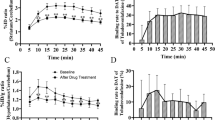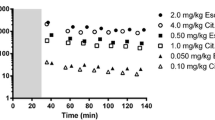Abstract
Rationale
Norepinephrine transporter (NET) is one of the key targets for antidepressants such as combined serotonin and norepinephrine reuptake inhibitors as well as some of the tricyclic antidepressants. Clomipramine, a tricyclic antidepressant, has been reported to have an active metabolite, desmethylclomipramine, which has high affinity for NET in vitro. However, the NET occupancy of clomipramine and desmethylclomipramine has not fully been evaluated in vivo.
Objectives
In this positron emission tomography (PET) study, we investigate NET occupancy by clomipramine and desmethylclomipramine, respectively, in non-human primates with a selective radioligand for NET, (S,S)-[18F]FMeNER-D2.
Methods
PET measurements were performed with (S,S)-[18F]FMeNER-D2 at baseline and after the intravenous administration of clomipramine and desmethylclomipramine, respectively. NET binding was calculated with the simplified reference tissue model using the caudate as reference region. NET occupancy was calculated as the difference in NET binding between the baseline and pretreatment condition. The relationship between NET occupancy and dose/plasma concentration was evaluated using hyperbolic functions.
Results
NET occupancy by both clomipramine and desmethylclomipramine increased in a dose and plasma concentration-dependent manner. The mean Kd values, expressed as the dose or plasma concentration at which 50% of NET was occupied, were 0.44 mg/kg and 24.5 ng/ml for clomipramine and 0.11 mg/kg and 4.4 ng/ml for desmethylclomipramine.
Conclusions
Not only desmethylclomipramine but also clomipramine was demonstrated to occupy NET in the non-human primate in vivo. It can thus be assumed that NET occupancy during clinical treatment with clomipramine is a combined effect of unchanged clomipramine and its main metabolite desmethylclomipramine.





Similar content being viewed by others
References
Aitchison K, Datla K, Rooprai H, Fernando J, Dexter D (2009) Regional distribution of clomipramine and desmethylclomipramine in rat brain and peripheral organs on chronic clomipramine administration. J Psychopharmacol 24:1261–1268
Altemus M, Swedo SE, Leonard HL, Richter D, Rubinow DR, Potter WZ, Rapoport JL (1994) Changes in cerebrospinal fluid neurochemistry during treatment of obsessive-compulsive disorder with clomipramine. Arch Gen Psychiatry 51:794–803
Bymaster FP, Dreshfield-Ahmad LJ, Threlkeld PG, Shaw JL, Thompson L, Nelson DL, Hemrick-Luecke SK, Wong DT (2001) Comparative affinity of duloxetine and venlafaxine for serotonin and norepinephrine transporters in vitro and in vivo, human serotonin receptor subtypes, and other neuronal receptors. Neuropsychopharmacology 25:871–880
Davies MA, Compton-Toth BA, Hufeisen SJ, Meltzer HY, Roth BL (2005) The highly efficacious actions of N-desmethylclozapine at muscarinic receptors are unique and not a common property of either typical or atypical antipsychotic drugs: is M1 agonism a pre-requisite for mimicking clozapine's actions? Psychopharmacology (Berl) 178:451–460
Eriksson E, Westberg P, Alling C, Thuresson K, Modigh K (1991) Cerebrospinal fluid levels of monoamine metabolites in panic disorder. Psychiatry Res 36:243–251
Faravelli C, Ballerini A, Ambonetti A, Broadhurst AD, Das M (1984) Plasma levels and clinical response during treatment with clomipramine. J Affect Disord 6:95–107
Farde L, Wiesel FA, Nordstrom AL, Sedvall G (1989) D1- and D2-dopamine receptor occupancy during treatment with conventional and atypical neuroleptics. Psychopharmacology (Berl) 99:S28–S31
Fineberg NA, Gale TM (2005) Evidence-based pharmacotherapy of obsessive-compulsive disorder. Int J Neuropsychopharmacol 8:107–129
Gillman PK (2007) Tricyclic antidepressant pharmacology and therapeutic drug interactions updated. Br J Pharmacol 151:737–748
Giuliano F, Hellstrom WJ (2008) The pharmacological treatment of premature ejaculation. BJU Int 102:668–675
Hendset M, Haslemo T, Rudberg I, Refsum H, Molden E (2006) The complexity of active metabolites in therapeutic drug monitoring of psychotropic drugs. Pharmacopsychiatry 39:121–127
Hyttel J (1982) Citalopram—pharmacological profile of a specific serotonin uptake inhibitor with antidepressant activity. Prog Neuropsychopharmacol Biol Psychiatry 6:277–295
Jensen NH, Rodriguiz RM, Caron MG, Wetsel WC, Rothman RB, Roth BL (2008) N-desalkylquetiapine, a potent norepinephrine reuptake inhibitor and partial 5-HT1A agonist, as a putative mediator of quetiapine's antidepressant activity. Neuropsychopharmacology 33:2303–2312
Karlsson P, Farde L, Halldin C, Swahn CG, Sedvall G, Foged C, Hansen KT, Skrumsager B (1993) PET examination of [11C]NNC 687 and [11C]NNC 756 as new radioligands for the D1-dopamine receptor. Psychopharmacology (Berl) 113:149–156
Koch S, Hemrick-Luecke SK, Thompson LK, Evans DC, Threlkeld PG, Nelson DL, Perry KW, Bymaster FP (2003) Comparison of effects of dual transporter inhibitors on monoamine transporters and extracellular levels in rats. Neuropharmacology 45:935–944
Lammertsma AA, Hume SP (1996) Simplified reference tissue model for PET receptor studies. Neuroimage 4:153–158
Martensson B, Wagner A, Beck O, Brodin K, Montero D, Asberg M (1991) Effects of clomipramine treatment on cerebrospinal fluid monoamine metabolites and platelet 3H-imipramine binding and serotonin uptake and concentration in major depressive disorder. Acta Psychiatr Scand 83:125–133
Meyer JH, Wilson AA, Sagrati S, Hussey D, Carella A, Potter WZ, Ginovart N, Spencer EP, Cheok A, Houle S (2004) Serotonin transporter occupancy of five selective serotonin reuptake inhibitors at different doses: an [11C]DASB positron emission tomography study. Am J Psychiatry 161:826–835
Nagy A, Johansson R (1977) The demethylation of imipramine and clomipramine as apparent from their plasma kinetics. Psychopharmacology (Berl) 54:125–131
Pilkington GJ, Parker K, Murray SA (2008) Approaches to mitochondrially mediated cancer therapy. Semin Cancer Biol 18:226–235
Schou M, Halldin C, Sovago J, Pike VW, Hall H, Gulyas B, Mozley PD, Dobson D, Shchukin E, Innis RB, Farde L (2004) PET evaluation of novel radiofluorinated reboxetine analogs as norepinephrine transporter probes in the monkey brain. Synapse 53:57–67
Schou M, Halldin C, Pike VW, Mozley PD, Dobson D, Innis RB, Farde L, Hall H (2005) Post-mortem human brain autoradiography of the norepinephrine transporter using (S,S)-[18F]FMeNER-D2. Eur Neuropsychopharmacol 15:517–520
Sekine M, Arakawa R, Ito H, Okumura M, Sasaki T, Takahashi H, Takano H, Okubo Y, Halldin C, Suhara T (2010) Norepinephrine transporter occupancy by antidepressant in human brain using positron emission tomography with (S,S)-[18F]FMeNER-D2. Psychopharmacology (Berl) 210:331–336
Seneca N, Gulyas B, Varrone A, Schou M, Airaksinen A, Tauscher J, Vandenhende F, Kielbasa W, Farde L, Innis RB, Halldin C (2006) Atomoxetine occupies the norepinephrine transporter in a dose-dependent fashion: a PET study in nonhuman primate brain using (S,S)-[18F]FMeNER-D2. Psychopharmacology (Berl) 188:119–127
Suhara T, Takano A, Sudo Y, Ichimiya T, Inoue M, Yasuno F, Ikoma Y, Okubo Y (2003) High levels of serotonin transporter occupancy with low-dose clomipramine in comparative occupancy study with fluvoxamine using positron emission tomography. Arch Gen Psychiatry 60:386–391
Swanson LW, Hartman BK (1975) The central adrenergic system. An immunofluorescence study of the location of cell bodies and their efferent connections in the rat utilizing dopamine-beta-hydroxylase as a marker. J Comp Neurol 163:467–505
Takano A, Gulyas B, Varrone A, Maguire RP, Halldin C (2009) Saturated norepinephrine transporter occupancy by atomoxetine relevant to clinical doses: a rhesus monkey study with (S,S)-[18F]FMeNER-D2. Eur J Nucl Med Mol Imaging 36:1308–1314
Tatsumi M, Groshan K, Blakely RD, Richelson E (1997) Pharmacological profile of antidepressants and related compounds at human monoamine transporters. Eur J Pharmacol 340:249–258
Trimble MR (1990) Worldwide use of clomipramine. J Clin Psychiatry 51:51–54, discussion 55–58
Vandel B, Vandel S, Jounet JM, Allers G, Volmat R (1982) Relationship between the plasma concentration of clomipramine and desmethylclomipramine in depressive patients and the clinical response. Eur J Clin Pharmacol 22:15–20
Varrone A, Sjoholm N, Eriksson L, Gulyas B, Halldin C, Farde L (2009) Advancement in PET quantification using 3D-OP-OSEM point spread function reconstruction with the HRRT. Eur J Nucl Med Mol Imaging 36:1639–1650
Acknowledgements
The authors thank Gudrun Nylen and all the members of the Karolinska PET group for their assistance in the PET experiments. This study was supported in part by Karolinska Institutet Foundation and the Swedish Science Council (41804).
Author information
Authors and Affiliations
Corresponding author
Rights and permissions
About this article
Cite this article
Takano, A., Nag, S., Gulyás, B. et al. NET occupancy by clomipramine and its active metabolite, desmethylclomipramine, in non-human primates in vivo. Psychopharmacology 216, 279–286 (2011). https://doi.org/10.1007/s00213-011-2212-9
Received:
Accepted:
Published:
Issue Date:
DOI: https://doi.org/10.1007/s00213-011-2212-9




